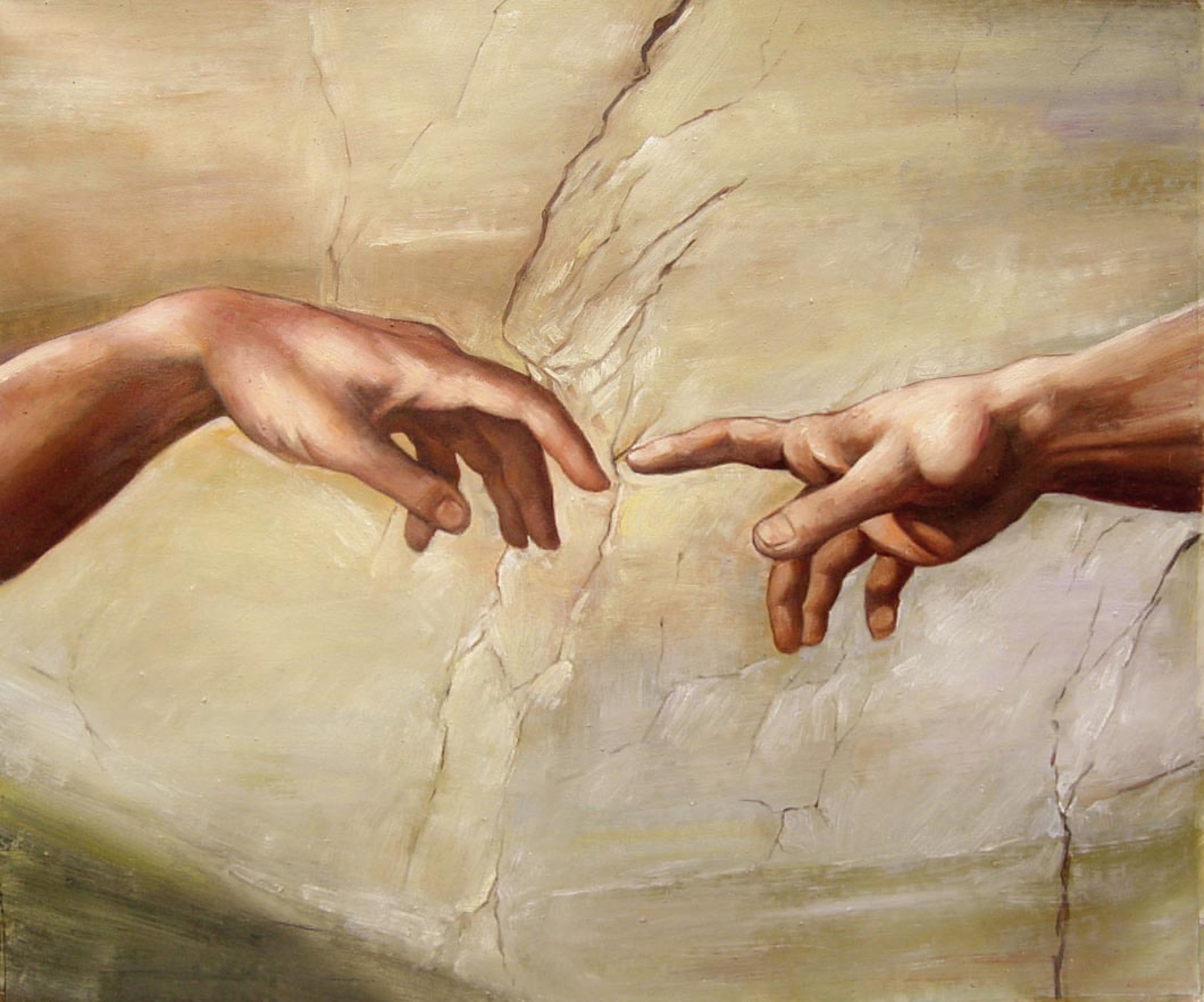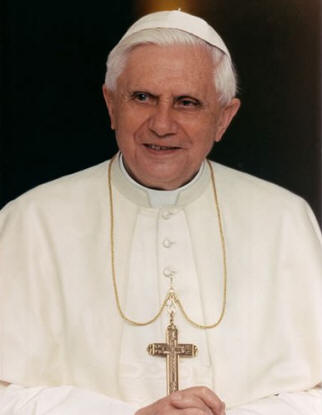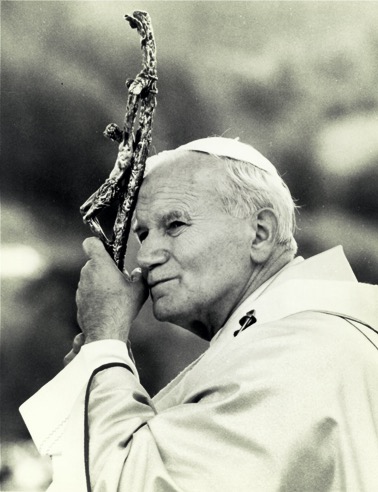
ON THE DIGNITY OF MAN AND WOMAN
THERE is a joy that we must rediscover as Christians today: the joy of seeing the face of God in the other—and this includes those who have compromised their sexuality. In our contemporary times, St. John Paul II, Blessed Mother Teresa, Servant of God Catherine de Hueck Doherty, Jean Vanier and others come to mind as individuals who found the capacity to recognize God’s image, even in the distressing disguise of poverty, brokenness, and sin. They saw, as it were, the “crucified Christ” in the other.
There is a tendency, particularly among fundamentalist Christians today, to “damn” others who are not “saved,” to blast the “immoral”, to chastise the “wicked”, and denounce the “depraved.” Yes, Scripture tells us what will become of any of us who persist in serious and mortal sin, which is utter rejection of God’s order. Those who attempt to water down the truth of the Final Judgment and reality of Hell [1]cf. Hell is for Real do a grave injustice and harm to souls. At the same time, Christ did not charge the Church to condemn, but to be gentle in her teaching, [2]cf. Gal 6:1 merciful to her enemies, [3]cf. Luke 6:36 and courageous to the point of death in service to the truth. [4]cf. Mark 8:36-38 But one cannot be truly merciful and loving unless there is an authentic understanding of our human dignity that encompasses not only the body and emotions, but soul of man.
With the coming release of a new encyclical on ecology, there is no better time to examine the greatest abuse of creation in our times, the…
…dissolution of the image of man, with extremely grave consequences. —Cardinal Joseph Ratzinger (BENEDICT XVI), May, 14, 2005, Rome; speech on European identity; CatholicCulture.org
THE TRUE “GIFT”
A strange idea reared its head during the recent Synod on the Family in Rome. In the interim report released by the Vatican, Section 50—which was not voted with approval by the Synod Fathers, but was published nonetheless—says that “Homosexuals have gifts and qualities to offer to the Christian community,” and asked whether our communities are capable of “valuing their sexual orientation, without compromising Catholic doctrine on the family and matrimony”. [5]cf. Relate post disceptationem, n. 50; press.vatican.va
First, I want to say that over the last ten years, I have dialogued behind the scenes with a number of men and women who have struggled with same-sex attraction.  In every circumstance, they approached me with the desire to find healing, for they could perceive that their emotions did not match their plumbing, so to speak. You might recall A Letter of Sorrow I received from one such young man. His description of his struggle is real and agonizing, as it is for many—some who are our sons, daughters, siblings, cousins, and friends (see The Third Way). It has been an incredible privilege to journey with these people. I see them as no different than myself or others I’ve counselled, insofar as many of us carry deep and pervasive struggles that prevent us from becoming truly whole in Christ and leave one grappling for peace.
In every circumstance, they approached me with the desire to find healing, for they could perceive that their emotions did not match their plumbing, so to speak. You might recall A Letter of Sorrow I received from one such young man. His description of his struggle is real and agonizing, as it is for many—some who are our sons, daughters, siblings, cousins, and friends (see The Third Way). It has been an incredible privilege to journey with these people. I see them as no different than myself or others I’ve counselled, insofar as many of us carry deep and pervasive struggles that prevent us from becoming truly whole in Christ and leave one grappling for peace.
But does being “gay” bring specific “gifts and qualities” to the Body of Christ? It is an important question related to a deeper search for meaning in our times as more and more people turn to fashion, tatoos, plastic surgery and “gender theory” to re-define themselves. [6]“Gender theory” is the idea that one’s biology can be set at birth, ie. male or female, but that one can determine his “gender” apart from his sex. Pope Francis has condemened this theory twice now. I put this question to a man I know who lived with another male for several years. He left that lifestyle and has since become a true model of Christian manhood to many. His response:
I don’t think that homosexuality should be raised on high as a gift and a treasure in and of itself. There are many gifts and treasures, living treasures, in and outside of the Church who have been formed into these gifts and
treasures in part because of the way they have lived with and through this tension… I have come to a place of honoring and blessing the struggles in my journey, without proclaiming them something good in and of themselves. A paradox, of course! God loves to use divine tension to form and grow and strengthen and sanctify us: His divine economy. May my life, faithfully lived (I have failed along the way and walk the razor edge even today) someday before or after I die, reveal a path of hope, a way to joy, a startling example of God’s good work in the most unexpected of lives.
In other words, the Cross—whatever shape and form it takes in our individual lives—always transforms us and bears fruit when we allow ourselves to be fastened to it. That is, when we live, even in our weaknesses and struggles, in obedience to Christ, we will bring gifts and qualities to others around us as a result of our becoming more like Christ. The language in the Synod report suggests that an inherent disorder in itself is a gift, which it never can be since it is in conflict with God’s order. After all, that is the language the Church has continually used in describing the homosexual tendency:
…men and women with homosexual tendencies “must be accepted with respect, compassion and sensitivity. Every sign of unjust discrimination in their regard should be avoided.” They are called, like other Christians, to live the virtue of chastity. The homosexual inclination is however “objectively disordered” and homosexual practices are “sins gravely contrary to chastity.” —Considerations Regarding Proposals to Give Legal Recognition to Unions Between Homosexual Persons; n. 4
Asking the Church community to begin “valuing their sexual orientation, without compromising Catholic doctrine on the family and matrimony” is a contradiction in principles. As countless men and women who have left the homosexual “lifestyle” can attest, their dignity goes beyond their sexuality to their entire being. As one of the subjects in the beautiful documentary The Third Way stated: “I am not gay. I am Dave.”
The true gift we have to offer is ourselves, not just our sexuality.
THE DEEPER DIGNITY
Sexuality is only one facet of who we are, though it speaks to something deeper  than mere flesh: it is an expression of the image of God.
than mere flesh: it is an expression of the image of God.
Relativizing the difference between the sexes… tacitly confirms those bleak theories which seek to remove all relevance from a human being’s masculinity or femininity, as if this were a purely biological matter. —POPE BENEDICT XVI, WorldNetDaily, December 30th, 2006
Still, contrary to what the media projects today, our human dignity does not hinge entirely upon our sexuality. Being made in God’s image means that we were created for Him with the capacity to love Him and love one another in a communion of persons. That is the highest dignity and glory that belongs to a man or woman.
That is why the life of the consecrated: of priests, nuns, and lay people in a state of celibacy is called a “prophetic” witness by the Church. Because their voluntary choice to live chastly points to a greater good, to something transcendent, something beyond the beautiful and solemn yet temporal act of sexual intercourse, and that is union with God. [7]‘May their witness become that more evident in this Year of the Consecrated that the Church is presently living.’ cf. Apostolic Letter of Pope Francis to All Consecrated People, www.vatican.va  Their witness is a “sign of contradiction” in a generation that believes it is “impossible” to be happy without an orgasm. But that is because we are also a generation that believes less and less in the Divine, and thus, less and less in our own capacity for the divine. As St. Paul wrote:
Their witness is a “sign of contradiction” in a generation that believes it is “impossible” to be happy without an orgasm. But that is because we are also a generation that believes less and less in the Divine, and thus, less and less in our own capacity for the divine. As St. Paul wrote:
For all of you who were baptized into Christ have clothed yourselves with Christ. There is neither Jew nor Greek, there is neither slave nor free person, there is not male and female; for you are all one in Christ Jesus. (Gal 3:27-28)
As the Saints testify, union with God exceeds the joys of the temporal as much as the Sun exceeds the light of a lamp. Still, it is wrong, a heresy in fact, to consider sexual intercourse as somehow a necessary “sin” for those “too weak” to embrace a celibate life. For if we are to speak about “union” with Christ, we must also see that sex is a beautiful reflection and anticipation of that union: Christ plants the “seed” of His Word in the heart of His Bride, the Church, which produces “life” within her. Indeed, the entirety of Scriptures are the story of a “marriage covenant” between God and His people that will culminate at the end of human history in the “wedding day of the Lamb.” [8]cf. Rev 19:7 In this regard, chastity is the anticipation of this eternal Wedding Feast.
CHASTITY: THE GREAT ANTICIPATION
Our sexuality does not define who we are in Christ—it defines who we are in the order of creation. Thus, the person struggling with their gender identity should never feel deprived of God’s love nor of their salvation, so long as they live their life in conformity with the natural moral law. But that must be said of all of us. In fact, the idea that chastity is only for the “celibate” is part of the impoverishment of our contemporary understanding of sexuality.
Sex has become an end in itself such that our generation cannot even conceive the possibility of consecrated life, let alone two  young people remaining chaste until marriage. And yet, in the Christian community through which I move, I see these young couples all the time. They too are a “sign of contradiction” in a generation that has reduced sexuality to mere recreation. But that does not mean that, once married, anything goes.
young people remaining chaste until marriage. And yet, in the Christian community through which I move, I see these young couples all the time. They too are a “sign of contradiction” in a generation that has reduced sexuality to mere recreation. But that does not mean that, once married, anything goes.
Carmen Marcoux, author of Arms of Love and co-founder of Pure Witness Ministries once said, “Purity is not a line we cross, it is a direction we go.” What a revolutionary insight! Because all too often, even Christians seeking to be in God’s will with their bodies reduce that end to questions such as, “Can we do this? Can we do that? What’s wrong with this? etc.” And yes, I will answer these questions soon enough in Part IV. But I didn’t start with these questions because purity has less to do with abstaining from immoral acts and more to do with a state of the heart. As Jesus said,
Blessed are the pure in heart, for they shall see God. (Matt 5:8)
This Scripture has to do with intention and desire. It has to do with the disposition to fulfill the law: to love the Lord your God with all your heart… and your neighbour as yourself. With this disposition in one’s heart, God and the good of your neighbour will come first in everything, including what happens in the bedroom. In the context of sexuality, then, it is not about what I can “get” from the other, but what I can “give.”
Hence, chastity is something that must also be part of Christian marriage. Chastity, in fact, is what sets us apart from the animal kingdom. In animals, sexual life…
…exists on the level of nature and the instinct linked to it, whereas in the case of people it exists on the level of the person and morality. —POPE JOHN PAUL II, Love and Responsibility, Kindle version by Pauline Books & Media, Loc 516
That is to say, rather bluntly, that a husband is not making love to a vagina, but to his wife. The natural God-given aspect of pleasure in sex, then, is not an end in itself, but must be carefully fostered and ordered by both the husband and wife  toward the communion of love. This happiness and well-being of the other, then, takes into account the natural cycles of the woman’s body as well as her emotional and physical capacities. Chastity is practiced by both the husband and wife in those times of abstinence from sexual intercourse either to space children in the growth of their families, or to foster their mutual love and order their appetites toward that end. [9]cf. “But it is equally true that it is exclusively in the former case that husband and wife are ready to abstain from intercourse during the fertile period as often as for reasonable motives the birth of another child is not desirable. And when the infertile period recurs, they use their married intimacy to express their mutual love and safeguard their fidelity toward one another. In doing this they certainly give proof of a true and authentic love.” —POPE PAUL VI, Humanae Vitae, n. 16
toward the communion of love. This happiness and well-being of the other, then, takes into account the natural cycles of the woman’s body as well as her emotional and physical capacities. Chastity is practiced by both the husband and wife in those times of abstinence from sexual intercourse either to space children in the growth of their families, or to foster their mutual love and order their appetites toward that end. [9]cf. “But it is equally true that it is exclusively in the former case that husband and wife are ready to abstain from intercourse during the fertile period as often as for reasonable motives the birth of another child is not desirable. And when the infertile period recurs, they use their married intimacy to express their mutual love and safeguard their fidelity toward one another. In doing this they certainly give proof of a true and authentic love.” —POPE PAUL VI, Humanae Vitae, n. 16
But chastity, because at its core it is a state of the heart, must also be expressed during sexual intimacy. How is that possible? In two ways. The first is that not every act that results in orgasm is therefore moral. Sex has to be expressed according to the Creator’s design, according, therefore, to the natural moral law, as we’ve discussed in Parts I and II. So in Part IV, we’ll examine in detail the question of what is lawful and what isn’t.
The second aspect of chastity during sexual intimacy has to do with the disposition of the heart toward the other: of seeing the face of Christ in one’s spouse.
In this regard, St. John Paul II offers a beautiful and practical teaching. Sexual arousal of a man and woman differ greatly between the sexes. If left to our fallen nature alone, a man could very easily “use” his wife, who takes much longer to reach arousal. John Paul II taught that a man should strive to bring his body into harmony with that of his wife such that…
man could very easily “use” his wife, who takes much longer to reach arousal. John Paul II taught that a man should strive to bring his body into harmony with that of his wife such that…
…the climax of sexual arousal takes place both in a man and in a woman, and that it occurs inasmuch as possible in both spouses at the same time. —POPE JOHN PAUL II, Love and Responsibility, Kindle version by Pauline Books & Media, Loc 4435f
That’s a profound insight that transcends pleasure while at the same time dignifying it by placing the focus of the marital act upon mutual self-giving. As Pope Paul VI said,
The Church is the first to praise and commend the application of human intelligence to an activity in which a rational creature such as man is so closely associated with his Creator. —POPE PAUL VI, Humanae Vitae, n. 16
And there is the key to understanding the role of chastity within marriage: the marital act between a husband and wife should reflect the complete self-giving of the Creator who laid His life down upon the “marriage bed” of the Cross. Sexual intimacy, which is sacramental, should also lead the other to God. In the beautiful story of the marriage of Tobiah and Sarah, her father instructs his soon to be son-in-law on their wedding night:
Take her and bring her safely to your father. (Tobit 7:12)
That is what a husband and a wife are ultimately to do: take one another, and their children, safely to the Father in Heaven.
Thus, “chastity of the heart” fosters not only true intimacy between a couple, but with God as well, because it recognizes the true dignity of both the man and woman. In this way, their relationship becomes a “sign” to one another and to the community of something greater: an anticipation of that eternal union when we will all be “one in Christ.”
RELATED READING
Footnotes
| ↑1 | cf. Hell is for Real |
|---|---|
| ↑2 | cf. Gal 6:1 |
| ↑3 | cf. Luke 6:36 |
| ↑4 | cf. Mark 8:36-38 |
| ↑5 | cf. Relate post disceptationem, n. 50; press.vatican.va |
| ↑6 | “Gender theory” is the idea that one’s biology can be set at birth, ie. male or female, but that one can determine his “gender” apart from his sex. Pope Francis has condemened this theory twice now. |
| ↑7 | ‘May their witness become that more evident in this Year of the Consecrated that the Church is presently living.’ cf. Apostolic Letter of Pope Francis to All Consecrated People, www.vatican.va |
| ↑8 | cf. Rev 19:7 |
| ↑9 | cf. “But it is equally true that it is exclusively in the former case that husband and wife are ready to abstain from intercourse during the fertile period as often as for reasonable motives the birth of another child is not desirable. And when the infertile period recurs, they use their married intimacy to express their mutual love and safeguard their fidelity toward one another. In doing this they certainly give proof of a true and authentic love.” —POPE PAUL VI, Humanae Vitae, n. 16 |

